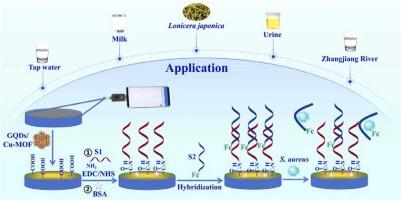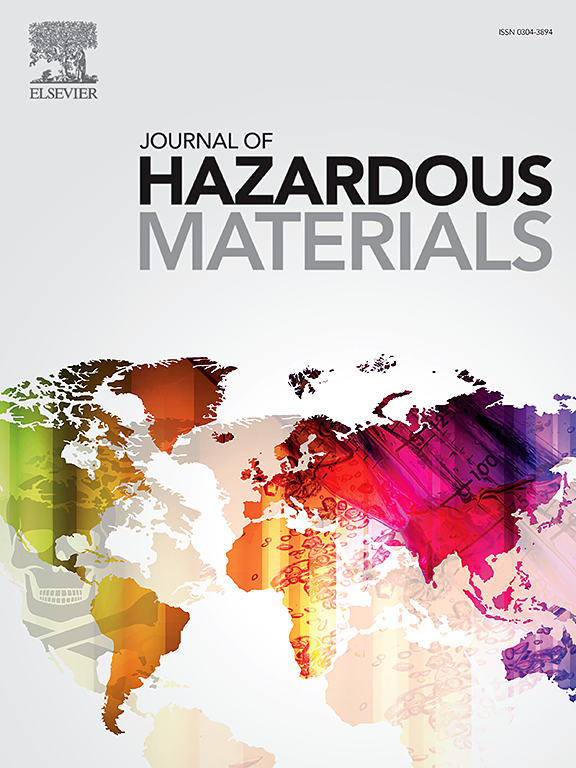基于石墨烯量子点/Cu-MOF纳米复合材料的新型比例电化学感应传感器用于金黄色葡萄球菌的现场检测
IF 12.2
1区 环境科学与生态学
Q1 ENGINEERING, ENVIRONMENTAL
引用次数: 0
摘要
金黄色葡萄球菌(S. aureus)的灵敏检测对保障公众健康和食品安全具有重要的现实意义。本研究利用石墨烯量子点/[Cu2.5(苯并三唑-5- coo)1.5(苯并三唑-5- cooh)0.5 (μ-Cl)0.5 (μ3-OH)-(H2O)]·3H2O纳米复合材料(GQDs/Cu-MOF)构建了一种灵敏稳定的比例电化学传感器,用于检测金黄色葡萄球菌。由于GQDs具有优异的导电性,并通过其丰富的羧基提供了稳定性,从而提高了电化学偶联传感器的灵敏度。Cu-MOF具有电活性,不仅提高了电化学传感器的性能,而且还起到了信号标签的作用。将单链DNA1 (S1)固定在GQDs/Cu-MOF/丝网印刷碳电极(S1/GQDs/Cu-MOF/SPCE)表面作为传感界面。随后,将S1/GQDs/Cu-MOF/SPCE与探针dna -二茂铁(S2-Fc)杂交,在体系内产生Cu-MOF (ICu-MOF)和s2 -二茂铁(IS2-FC)的电化学信号。然而,DNA在传感界面的电子传递性能受到损害,导致ICu-MOF的降低。当系统中存在金黄色葡萄球菌时,S2-Fc与其反应并脱离传感表面,导致IS2-FC逐渐降低,ICu-MOF升高。建立的比例电化学配体传感器检测金黄色葡萄球菌的灵敏度为0.97 CFU·mL-1,稳定性好,线性范围宽。该传感器已成功应用于自来水、牛奶、金银花、尿液和张江河水中金黄色葡萄球菌的检测。此外,该传感器设计可适用于其他食源性致病菌的检测,表明该传感器设计方案具有良好的通用性。本文章由计算机程序翻译,如有差异,请以英文原文为准。

A novel ratiometric electrochemical aptasensor based on graphene quantum dots/Cu-MOF nanocomposite for the on-site determination of Staphylococcus aureus
The sensitive detection of Staphylococcus aureus (S. aureus) holds great practical importance for ensuring public health and food safety. In this study, a sensitivity and stability ratiometric electrochemical aptasensor using graphene quantum dots/[Cu2.5 (benzotriazole-5-COO)1.5 (benzotriazole-5-COOH)0.5 (μ-Cl)0.5 (μ3-OH)-(H2O)]·3 H2O nanocomposite (GQDs/Cu-MOF) was constructed for S. aureus detection. The GQDs enhanced the sensitivity of the electrochemical aptasensor due to their excellent conductivity and provided stability through their abundant carboxyl groups. The Cu-MOF, possessing electrical activity, not only enhanced the performance of the electrochemical aptasensor but also served as a signal label. The single-stranded DNA1 (S1) was immobilized on the surface of a GQDs/Cu-MOF/screen-printed carbon electrode (S1/GQDs/Cu-MOF/SPCE) as the sensing interface. Subsequently, the S1/GQDs/Cu-MOF/SPCE was hybridized with the probe DNA-ferrocene (S2-Fc), resulting in the generation of electrochemical signals from Cu-MOF (ICu-MOF) and S2-ferrocene (IS2-FC) within the system. However, the electron transfer performance of DNA at the sensing interface was compromised, leading to a reduction in the ICu-MOF. When S. aureus was present in the system, S2-Fc reacted with it and detached from the sensing surface, resulting in a gradual decrease in IS2-FC and an increase in ICu-MOF. Then a ratiometric electrochemical aptasensor was established for S. aureus detection with remarkable sensitivity (0.97 CFU·mL−1), excellent stability, and a broad linear range. Furthermore, the aptasensor was successfully applied to detect S. aureus in tap water, milk, Lonicera japonica, urine, and Zhangjiang River. Additionally, this aptasensor design can be adapted for the detection of other foodborne pathogens, which indicates that the design scheme of the aptasensor has good universality.
求助全文
通过发布文献求助,成功后即可免费获取论文全文。
去求助
来源期刊

Journal of Hazardous Materials
工程技术-工程:环境
CiteScore
25.40
自引率
5.90%
发文量
3059
审稿时长
58 days
期刊介绍:
The Journal of Hazardous Materials serves as a global platform for promoting cutting-edge research in the field of Environmental Science and Engineering. Our publication features a wide range of articles, including full-length research papers, review articles, and perspectives, with the aim of enhancing our understanding of the dangers and risks associated with various materials concerning public health and the environment. It is important to note that the term "environmental contaminants" refers specifically to substances that pose hazardous effects through contamination, while excluding those that do not have such impacts on the environment or human health. Moreover, we emphasize the distinction between wastes and hazardous materials in order to provide further clarity on the scope of the journal. We have a keen interest in exploring specific compounds and microbial agents that have adverse effects on the environment.
 求助内容:
求助内容: 应助结果提醒方式:
应助结果提醒方式:


